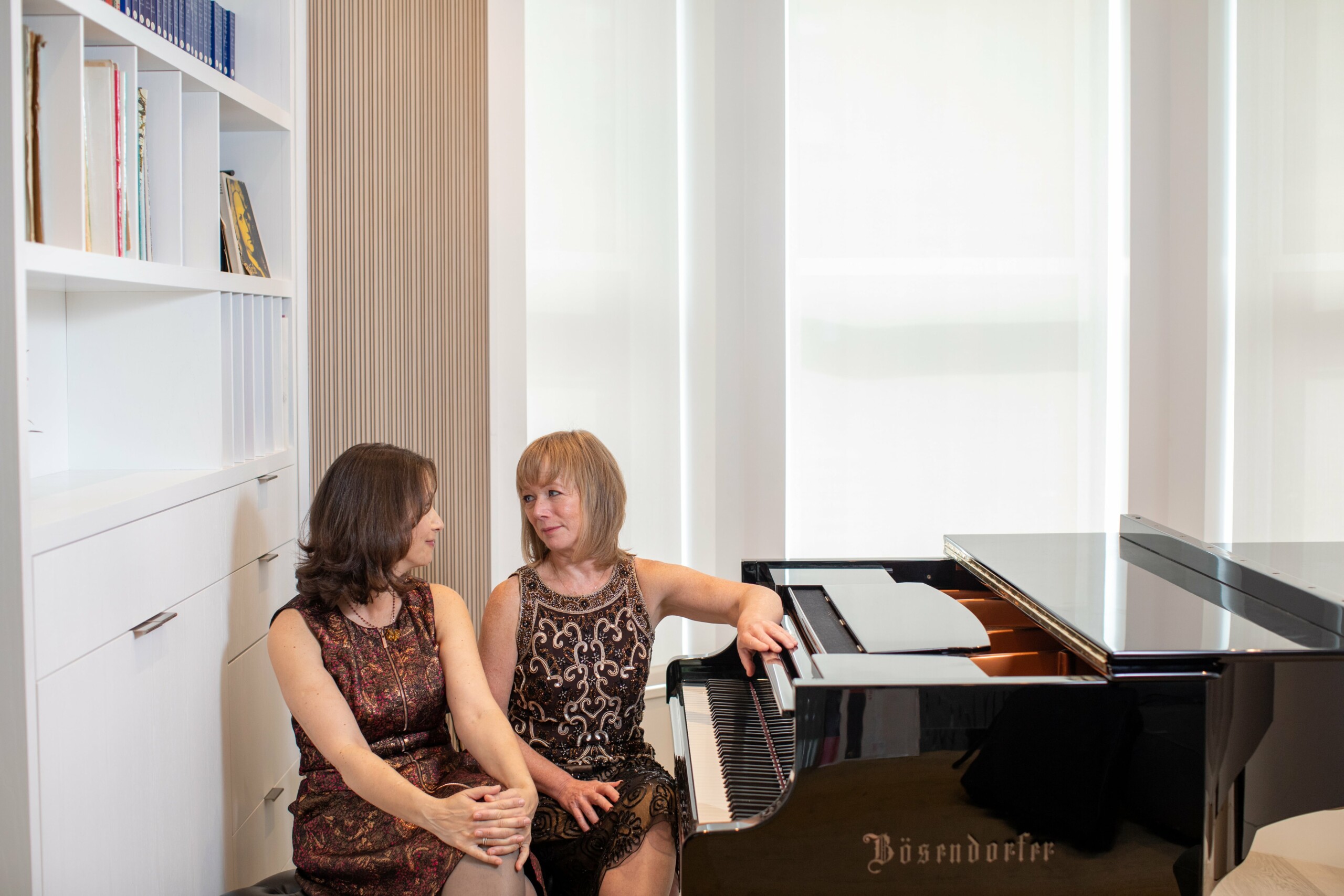Today, November 11, pianist Eleonor Bindman releases a recording, with duo partner Susan Sobolewski, of J.S. Bach’s four Orchestral Suites – transcribed by Bindman for four-hands piano – on Naxos’s Grand Piano label. This new rendering of the orchestral suites helps to fill a much-neglected area of the chamber music literature, the value of four-hands piano music far surpassing its current level of fashion. This new arrangement is also designed to appeal to both students and professionals, with difficulty levels varying from movement to movement.
The orchestral suites are one of only two sets of secular orchestral works by Bach. Bindman’s 2018 release of her own four-hands transcription of the other set – the six Brandenburg Concertos – with duet partner Jenny Lin was declared by Pianist magazine to be “breathtaking in its sheer precision and vitality” and quickly became Grand Piano’s best-selling album of that year. Together, the Brandenburg Concertos and Orchestral Suites comprise a total of 42 movements lasting over three hours; the transcribing/recording project took several years for Bindman to complete. The score for the four-hands transcription of the orchestral suites can be purchased from Bindman’s website here, and a trailer for the new recording can be seen here.
In the early 20th century, illustrious composer and conductor Max Reger likewise made a four-hands transcription of the Brandenburgs and orchestral suites, and that version has stood as the only option until now. But the Reger version is problematic from the standpoint of the pianists, and as a result is seldom if ever performed. The famed piano duo Anderson & Roe recorded only Brandenburg Concerto No. 3 in Reger’s version, and even in that case re-worked it afterward to make it practical for performance. No other duo of note has ever attempted those versions. As Bindman says:
“I’ve played four-hands piano music for over 30 years and I’ve always wanted to play these concertos. But my partners and I found that most of the material is concentrated in the top part: they are very difficult for one person and not at all an interesting showcase for the other. Reger did so many fantastic arrangements, but in this case I’m guessing he was just too busy to address them properly.”
The repertoire specially composed for piano duet is scarce and long overdue for a fresh infusion of repertoire. Mozart wrote a handful of sonatas to be played four-hands, and Schubert’s Fantasie in F minor uses the same scoring. Debussy also dabbled in the form, as did a few other composers in the late 19th and early 20th centuries, but much of that music was designed for the teaching studio and apart from it few composers have been inspired by the configuration. Teaching studios might be the one place four-hands playing is still broadly valued, since it permits students to learn about things like rhythm, balance and interpretation not only intellectually but through imitation of their teachers as they play along. Yet during the late 18th and early 19th centuries, when domestic music-making was at its peak and most city homes had a piano, transcriptions for piano duet were the preferred way to bring popular orchestral and operatic works into the home.
In a professional musical environment that has seen a welcome resurgence of interest in collaboration between star solo artists, it’s surprising that piano duets would not have seen a rise in status, but Bindman’s transcriptions of Bach’s entire output of secular orchestral works represent an important step toward raising the profile of the configuration. The decline of the piano duet tradition is a pity, because as Bindman is quick to point out, four-hands piano is one of the most intimate forms of chamber music available to performers. As she says:
“You’re so close to the other person that you’re making music with, which might make some pianists shy away. Your hands are very close together and it’s very intimate, so you find a lot of siblings and married couples playing piano duets. The sensation of music-making is very vivid; if you’re a trio or a quartet you’re sitting six feet from each other, but with four-hands piano you’re literally sitting next to this person on the bench. It’s fantastic if you like the person you’re sitting next to.”
About the Performers
Pianist, arranger and teacher Eleonor Bindman is known worldwide for “Bach playing of the highest order” (Pianodao), and combines her passions of teaching and performing to bring new repertoire to light through her original transcriptions, scores and recordings. Her 2018 recording of Bach’s Brandenburg Concertos was followed by Stepping Stones to Bach, a set of 48 easy/intermediate piano arrangements, followed by the unprecedented Cello Suites for Solo Piano and, most recently, Bach’s complete keyboard Partitas released on the Delos label. Reviewing that recording, Fanfare declared the Sarabande from Partita No. 3 to be “an absolutely hypnotizing and eloquently grave meditation.”
Bindman’s discography also includes Tchaikovsky’s The Seasons (MSR Classics) and an album of works by Mussorgsky, both featuring her own transcriptions. As Duo Vivace, she and Susan Sobolewski released Out of the Blue, featuring works by Holst, Bernstein and Gershwin. Her early training on piano was in the lineage of legendary Moscow Conservatory pedagogue Heinrich Neuhaus: her first piano teacher, Rita Kroner, studied with Neuhaus’s pupil and assistant Teodor Gutman. Continuing her studies in the U.S., she received her MA in piano pedagogy at SUNY, New Paltz under the guidance of Moscow Conservatory alum Vladimir Feltsman. An active recording artist, performer and teacher, she is currently based in New York City.
Susan Sobolewski has had a performing career spanning three continents, including several tours as an artistic ambassador in India. She has also performed as a recitalist in the UK, Denmark, Canada, the Caribbean and across the United States, with New York performances including solo, chamber and orchestral concerts at Carnegie Hall, Weill Recital Hall, Merkin Hall, Alice Tully Hall, Steinway Hall and the Abrons Art Center. In 2020 she created, curated and performed a Music Meditations series: 38 weekly editions of solo performances, essays and photographs for subscribers worldwide.

